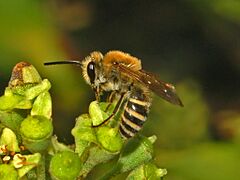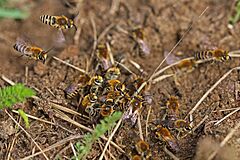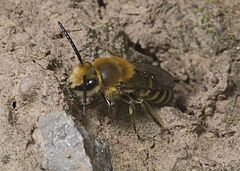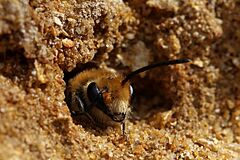Ivy bee facts for kids
Quick facts for kids Ivy bee |
|
|---|---|
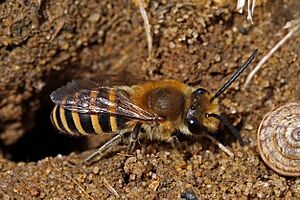 |
|
| male Dry Sandford Pit, Oxfordshire |
|
| Scientific classification | |
| Genus: |
Colletes
|
| Species: |
hederae
|
Colletes hederae, the ivy bee, is a species of plasterer bee belonging to the family Colletidae subfamily Colletinae.
Contents
Taxonomy
These mining bees have been only recently described (Schmidt & Westrich 1993) as a distinct species. Until then, they were confused with another species of Colletes the morphologically very similar, but ecologically distinctive, Colletes halophilus.
Distribution
They are known from Austria, Belgium, Channel Islands, Croatia, Cyprus, southern England, Wales, France, Germany, Greece, Ireland, Italy, Luxembourg, Netherlands, Serbia, Slovenia, Spain and Switzerland.
Description
The females of Colletes hederae are on average 13 millimetres (0.51 in) long, while the males are about 10 mm (0.39 in) long, significantly larger than the common colletes. The thorax of the adults is covered by dense orange-brown hair, while each abdominal segment has an apical orangey hair-band.
This species is very similar to the closely related heather colletes (Colletes succinctus) and even more to the sea aster mining bee (Colletes halophilus).
Biology
The adults emerge late in the year (the males from late August and the females a little later in early September) and remain on the wing until early November. The principal pollen forage plant is ivy (Hedera helix) (hence the specific epithet hederae), but both sexes will also nectar at ivy flowers too. When ivy is scarce, other species of plants are also visited. The females supply the larval brood cells almost exclusively with nectar and pollen of ivy flowers. When ivy flowering is delayed, females may also collect pollen at various members of the Daisy family (Asteraceae).
These are solitary bees and do not live in colonies and do not overwinter as adults. They nest in clay-sandy soils, especially in loess hills and soft-rock cliffs. Like many other solitary bees, they can often be found nesting in dense aggregations, sometimes numbering many tens of thousands of nests. In parts of the west European range of the species, Colletes hederae are frequently parasitized by the larvae of the meloid beetle Stenoria analis, which feed on the supply of nectar and pollen prepared by females bees in their nests.
Gallery
-
Male, feeding on Hedera helix


